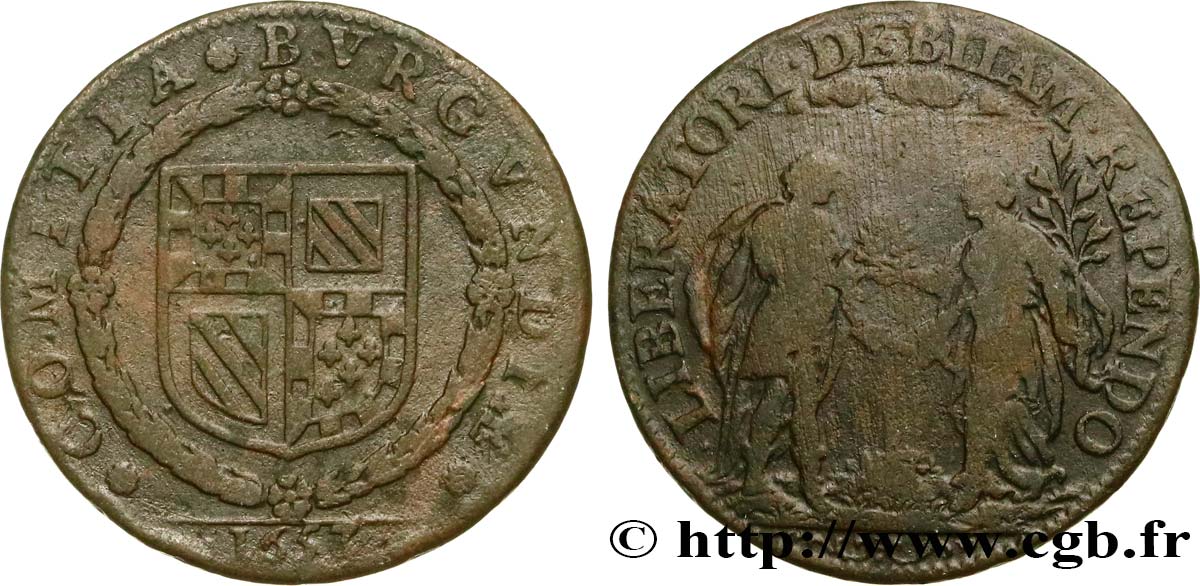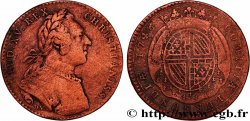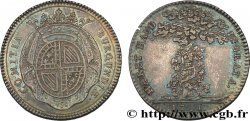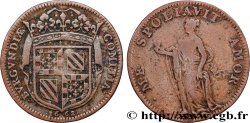E-auction 232-156527 - fjt_058946 - BURGUNDY (STATES OF...) Fin de la Fronde 1653
You must signin and be an approved bidder to bid, LOGIN TO BID. Accounts are subject to approval and the approval process takes place within 48 hours. Do not wait until the day a sale closes to register. Clicking on « bid » constitutes acceptance of the terms of use of cgb.fr private e-auctions.
Bids must be placed in whole Euro amounts only. The sale will start closing at the time stated on the item description; any bids received at the site after the closing time will not be executed. Transmission times may vary and bids could be rejected if you wait until the last second. For further information ckeck the E-auctions F.A.Q.
NO BUYER'S FEE.
NO BUYER'S FEE.
| Estimate : | 12 € |
| Price : | 6 € |
| Maximum bid : | 8 € |
| End of the sale : | 25 September 2017 18:23:30 |
| bidders : | 4 bidders |
Type : Fin de la Fronde
Date: 1653
Metal : copper
Diameter : 27 mm
Orientation dies : 6 h.
Edge : lisse
Obverse
Obverse legend : * COMITIA * BVRGVNDIÆ *.
Obverse description : Armes de Bourgogne dans une couronne ; à l’exergue : .1653..
Obverse translation : (États de Bourgogne).
Reverse
Reverse legend : .LIBERATORI. DEBITAM. REPENDO.
Reverse description : La province de Bourgogne offre une couronne de laurier au jeune roi, à l’arrière une ville ; à l’exergue un fleuron.
Reverse translation : J'offre à mon libérateur la couronne qui lui est due.
Commentary
Les Frondeurs se réfugièrent une nouvelle fois à Seurre lorsqu’ils apprirent la libération du prince de Condé. Durant l’exil de celui-ci en Guyenne, la ville est prise par d’Épernon qui fait raser les fortifications. Le roi est présenté comme le libérateur de la province.
Les États de Bourgogne ont fait l'objet de plusieurs études : Rossignol en 1851 ; Preux dans l'ASFN en 1867 et Fontenay, Manuel de l'amateur de jetons, 1854 auquel nous empruntons de nombreuses descriptions de jetons ainsi que les commentaires suivants : "Les États de Bourgogne votaient les impôts, aides et subsides. La province réglait son administration économique dans des assemblées générales, et après les sessions, l'exécution des votes appartenait à des Élus généraux pris dans tous les rangs de la société et dont la conduite était censurée à chaque triennalité par des commissaires spéciaux et indépendants. Les Élus faisaient la répartition des impôts, et pour cela ils nommaient de droit tous leurs officiers, ordonnaient les constructions publiques et les réparations des grandes routes, réglaient la levée et la dépense des milices, opéraient la liquidation des étapes, l'adjudication des octrois sur la Saône et tenaient en leurs mains l'importante direction des crues sur le sel que l'on ne pouvait amener en Bourgogne sans leur approbation. Les habitants n'étaient point traduits hors de leur ressort. Les États avaient le droit de rembourser de leurs finances tout office à la charge du pays ; le roi ne pouvait en créer de nouveaux sans le consentement de la province, et moins encore disposer de la province sans son aveu. (...) Quelques mots suffiront pour donner une idée de l'organisation des États de Bourgogne. Ils se composaient des trois positions sociales ou des trois Ordres de la société, le Clergé, la Noblesse et le Tiers-État. Le premier représentait la sagesse, les lumières et la bonté ; le second, la force, la gloire et la grandeur ; le troisième, l'industrie, le commerce et l'agriculture. On ne pouvait trouver rien de plus juste et de plus complet. L'inégalité numérique des trois Ordres disparaissait au moment du vote : au moment solennel de la décision, il n'y avait que trois voix ; et celle du Tiers, qui eût été insignifiante si l'on avait compté par têtes, avait le pouvoir de faire pencher la balance du côté où elle voulait. La représentation des pouvoirs se complétait par la présence aux États des envoyés de Mgr le Duc et plus tard de ceux de Sa Majesté. L'Élu du premier avait pour mission de veiller d'une manière toute spéciale sur les intérêts de la couronne ducale et de l'édifier sur tout ce qui se passait dans l'administration des finances. Sous le régime monarchique, le roi s'appuyait encore sur le Parlement dont le président prenait la parole à l'ouverture des États pour soutenir les demandes de la couronne ; il avait de plus l'intendant et le gouverneur de la province ; puis la chambre des comptes dont les Maîtres étaient plus habitués que personne au maniement des jetons. Après une session d'un mois, l'assemblée générale laissait pour administrer le pays, pendant trois années, une petite assemblée ou Chambre des Élus généraux composée, comme elle, des éléments intéressés, c'est-à-dire appartenant aux trois Ordres. L'Élu du roi, deux députés de la chambre des comptes, le trésorier général et l'intendant de la province avaient droit d'y entrer pour la couronne, comme les deux secrétaires des États, mais sans voix délibérative. L'Élu de la Noblesse était seul électif ; ceux du Clergé et du Tiers arrivaient alternativement à la Chambre. L'Église fournissait tantôt un évêque, tantôt un abbé, tantôt un doyen de la province à tour de rôle. Le représentant du Tiers-État était successivement un maire de l'une des quatorze villes inscrites à la grande roue ; et par privilège, cet Ordre avait encore son président-né, le maire de Dijon. Les petites villes ainsi que les chanoines et les prieurs n'étaient pas privés de leur part de pouvoir, car c'est dans leur sein que se recrutait la majeure partie des Alcades. Les Alcades formaient un conseil de censure qui recherchait en outre les choses utiles à proposer au pays et surveillait les opérations de la grande roue. Ils composaient un conseil suprême pour protéger la province contre l'erreur, la négligence, le mauvais vouloir ou l'ambition de ses administrateurs. En somme, le grand conseil était jugé par le petit.
Les États de Bourgogne ont fait l'objet de plusieurs études : Rossignol en 1851 ; Preux dans l'ASFN en 1867 et Fontenay, Manuel de l'amateur de jetons, 1854 auquel nous empruntons de nombreuses descriptions de jetons ainsi que les commentaires suivants : "Les États de Bourgogne votaient les impôts, aides et subsides. La province réglait son administration économique dans des assemblées générales, et après les sessions, l'exécution des votes appartenait à des Élus généraux pris dans tous les rangs de la société et dont la conduite était censurée à chaque triennalité par des commissaires spéciaux et indépendants. Les Élus faisaient la répartition des impôts, et pour cela ils nommaient de droit tous leurs officiers, ordonnaient les constructions publiques et les réparations des grandes routes, réglaient la levée et la dépense des milices, opéraient la liquidation des étapes, l'adjudication des octrois sur la Saône et tenaient en leurs mains l'importante direction des crues sur le sel que l'on ne pouvait amener en Bourgogne sans leur approbation. Les habitants n'étaient point traduits hors de leur ressort. Les États avaient le droit de rembourser de leurs finances tout office à la charge du pays ; le roi ne pouvait en créer de nouveaux sans le consentement de la province, et moins encore disposer de la province sans son aveu. (...) Quelques mots suffiront pour donner une idée de l'organisation des États de Bourgogne. Ils se composaient des trois positions sociales ou des trois Ordres de la société, le Clergé, la Noblesse et le Tiers-État. Le premier représentait la sagesse, les lumières et la bonté ; le second, la force, la gloire et la grandeur ; le troisième, l'industrie, le commerce et l'agriculture. On ne pouvait trouver rien de plus juste et de plus complet. L'inégalité numérique des trois Ordres disparaissait au moment du vote : au moment solennel de la décision, il n'y avait que trois voix ; et celle du Tiers, qui eût été insignifiante si l'on avait compté par têtes, avait le pouvoir de faire pencher la balance du côté où elle voulait. La représentation des pouvoirs se complétait par la présence aux États des envoyés de Mgr le Duc et plus tard de ceux de Sa Majesté. L'Élu du premier avait pour mission de veiller d'une manière toute spéciale sur les intérêts de la couronne ducale et de l'édifier sur tout ce qui se passait dans l'administration des finances. Sous le régime monarchique, le roi s'appuyait encore sur le Parlement dont le président prenait la parole à l'ouverture des États pour soutenir les demandes de la couronne ; il avait de plus l'intendant et le gouverneur de la province ; puis la chambre des comptes dont les Maîtres étaient plus habitués que personne au maniement des jetons. Après une session d'un mois, l'assemblée générale laissait pour administrer le pays, pendant trois années, une petite assemblée ou Chambre des Élus généraux composée, comme elle, des éléments intéressés, c'est-à-dire appartenant aux trois Ordres. L'Élu du roi, deux députés de la chambre des comptes, le trésorier général et l'intendant de la province avaient droit d'y entrer pour la couronne, comme les deux secrétaires des États, mais sans voix délibérative. L'Élu de la Noblesse était seul électif ; ceux du Clergé et du Tiers arrivaient alternativement à la Chambre. L'Église fournissait tantôt un évêque, tantôt un abbé, tantôt un doyen de la province à tour de rôle. Le représentant du Tiers-État était successivement un maire de l'une des quatorze villes inscrites à la grande roue ; et par privilège, cet Ordre avait encore son président-né, le maire de Dijon. Les petites villes ainsi que les chanoines et les prieurs n'étaient pas privés de leur part de pouvoir, car c'est dans leur sein que se recrutait la majeure partie des Alcades. Les Alcades formaient un conseil de censure qui recherchait en outre les choses utiles à proposer au pays et surveillait les opérations de la grande roue. Ils composaient un conseil suprême pour protéger la province contre l'erreur, la négligence, le mauvais vouloir ou l'ambition de ses administrateurs. En somme, le grand conseil était jugé par le petit.








 Report a mistake
Report a mistake Print the page
Print the page Share my selection
Share my selection Ask a question
Ask a question Consign / sell
Consign / sell
 Full data
Full data









